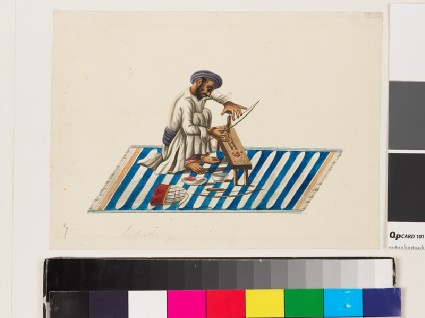Browse: 772 objects
- Reference URL
Actions
Lapidary at work
-
Details
- Associated place
-
Asia › India › east India › Bihar › Patna (probable place of creation)
- Date
- c. 1810
- Artist/maker
-
attributed to Sewak Ram (c. 1770 - c. 1830) (artist)
- Material and technique
- gouache on paper
- Dimensions
-
mount 40.6 x 27.9 cm (height x width)
page 13.9 x 19.2 cm max. (height x width)
- Material index
- Technique index
- Object type index
- No. of items
- 1
- Credit line
- Purchased, 1966.
- Accession no.
- EA1966.232
-
Further reading
Harle, J. C., and Andrew Topsfield, Indian Art in the Ashmolean Museum (Oxford: Ashmolean Museum, 1987), no. 95 on p. 84, pp. 83 & 86, illus. p. 85
Location
-
- currently in research collection
Objects are sometimes moved to a different location. Our object location data is usually updated on a monthly basis. Contact the Jameel Study Centre if you are planning to visit the museum to see a particular object on display, or would like to arrange an appointment to see an object in our reserve collections.
Publications online
-

Indian Art in the Ashmolean Museum
An East India Company factory has long been established at Patna on the river Ganges in the late 18th century, and as the British strengthened their hold over northern India from Bengal, the city became an important administrative centre. A number of Indian artists, deprived of their traditional patronage by the Mughal nobility, migrated elsewhere, while others came to settle in Patna and began selling series of vignettes of Indian life in a Europeanised style to foreign residents and visitors in search of the picturesque. Sewak Rām (c.1770-c.1830), one of the earliest of the migrants, came from Murshidabad and by the turn of the 19th century had a successful bazaar shop specialising in sets of paintings of Indian trades, costumes and festivals. He was a conscientious artist, working in a sombre palette attuned to the British taste, who did much to establish the pictorial conventions of the Patna school [see EAX.2030]. This study of a lapidary seated on a darī, cutting precious stones with a bow-drill, is one of two pictures attributed to Sewak Rām in the Museum’s collection.
© 2013 University of Oxford - Ashmolean Museum

